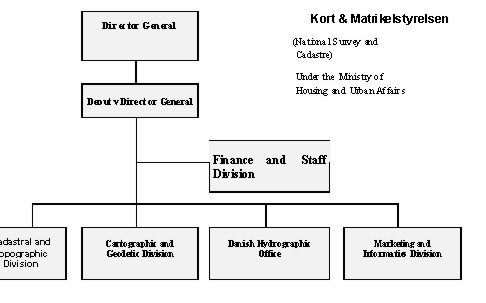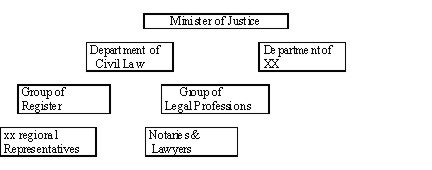|

|
Figure 1. Switzerland |
Organisation Diagrams
 |
Figure 2. Denmark |
Other examples can be found in the annex.
Question 2 - Philosophy
It was asked why is the structure like it is. The most given answers were '..because it is regulated by law.., ...it is been like this all the time... or ...unknown reason..'. In nearly all cases history and local mentality runs like a red line through the organisational structures of the respective country.
If the reason for surveying is originated in military purposes the main department of surveying is located in the defense ministry structure. If the reason is originated in tax purposes surveying is lead by the ministry of finance and so on. (agriculture, navy, law)
And once being built up it is nearly impossible to change this organisational structure. Sometimes this can happen the other way round as well. Denmark for example the cadastral department (part of Minister of Agriculture), the Geodetic Institute (part of Minister of Defense) and the Nautic Mapping Division (part of Minister of Traffic) amalgamated in 1989 and established the Danish Survey and cadastre.
Sometimes parts of surveying activities simply disappear if they are not necessary any longer and with them the organisational structure for that activity as well.
Question 3 - Functions and Responsibilities
With this question we want to know who does the daily routine work and who is responsible for it. Some countries had difficulties to give an answer because the respective activity does not exist in this country or is not carried out by surveyors in the sense of FIG. But there are results and you can see some trends.
|
Private sector |
% |
Public sector |
% |
|
Engineering surveying |
100 |
Rural planning |
100 |
|
Building design/construct |
91 |
Urban planning |
100 |
|
Topographical surveying |
82 |
Land registration |
91 |
|
Valuation |
73 |
Cadastral surveying |
82 |
|
Hydrographic surveying |
55 |
Geodetic surveying |
82 |
|
Cadastral surveying |
45 |
Hydrographic surveying |
82 |
|
Urban planning |
45 |
Land management |
82 |
|
Rural planning |
45 |
Building design/construct |
82 |
|
Geodetic surveying |
36 |
Topographic surveying |
73 |
|
Land management |
36 |
Valuation |
64 |
|
Land registration |
27 |
Engineering surveying |
36 |
If you calculate the average of given answers you can see that 80 % of the work is done by the public sector and only 58 % by the private sector.
With this questionnaire it was asked who does the work and not who should do the work. We might find that out with a second step and maybe with a different result.
List of answers where services are being carried out in both sectors:
|
Both sectors |
% |
|
Building design/construct |
73 |
|
Topographical s. |
55 |
|
Urban planning |
45 |
|
Rural planning |
45 |
|
Engineering s. |
36 |
|
Hydrographic s. |
36 |
|
Valuation |
36 |
|
Land management |
27 |
|
Cadastral s. |
27 |
|
Geodetic s. |
18 |
|
Land registration |
18 |
Amazingly in nearly no answer to the questionnaire the box 'other' than public or private was ticked. I think a possible reason for that is a kind of misunderstanding the question or possibly this type does not exist at all. Maybe an explanation or a clear definition would have been helpful to get answers for what Commission 1 is looking for. Let me ask a question to give an example: Is a PLC (Public Limited Company) still a private supplier of services if the majority of shares is held by the state? This question should have been clarified before being able to draw proper conclusions.
In some countries there are a kind of cooperatives or public law cooperations in use which provide surveying services. Sometimes you will find trade associations of communities, municipalities or local authorities to perform surveying activities.
Question 4 - Contracts and Penalties
It is quite difficult for me to work out reasonable results out of the given answers. First I have to become an expert in different languages because most of the answers were given in the language of origin. But nevertheless in discussions with colleagues I found out that all over the world the terms of 'deadlines', 'warranty' and 'penalties' are well known and in use. I guess that is rather an economic reality than a specific issue of FIG activities.
CONCLUSIONS
An organisational structure in general should be slim, easy to handle and reduced to the indispensable needs. Therefore activities must be defined in advance where supervision is needed. If there are services which are based on constitutional rights or laws the government might build up a convenient structure to guarantee these rights. All other activities could been monitored by a selfgoverning professional body and legal regulations.
Example:

Example:

However these are no recommendations which can simply be taken over but only a presentation of possible models which might serve as a starting point to think about different solutions. Working party 1 will continue its work on this issue. International agencies and governments – particularly in developing countries and countries in economic transition will then benefit from these results.
One key issue seems to be the transition from a proprietor-based to a parcel-based registration system. Switzerland did this transition with the introduction of Civil-Law in 1912. The second key issue is the introduction of a system that land registry has to be based on official cadastral surveying. With highly qualified colleagues carrying out this work high quality of service can be guaranteed.
Though there is no need to impose any of the presented structures. Whatever type of structure to be implemented it should be sown and nurtured carefully by recognizing local history, culture and economic requirements.
REFERENCES
Questionnaire of WG 1
Dipl.-Ing. Klaus Rürup is currently Vice Chair of FIG Commission 1 (Professional Standards and Practice) and Vice President of CLGE (Comite de Liaison des Geometres Europeens). From 1994 to 1998 he acted as Secretary of FIG Commission 1.
Since 1978 he runs his own surveying business in Bottrop. He is member of a number of committees and member of the examination board for surveying technichians in Münster.
Dipl.-Ing. Klaus Rürup
Vice Chair Commission 1
E-mail klaus.ruerup@t-online.de
18 April 2000